"Nintendo wanted to see Rabbid-ness to its full force”: Ubisoft on the making of Mario + Rabbids: Kingdom Battle, a crossover game like no other
How a small team’s passion convinced Nintendo to let chaos reign in the Mushroom Kingdom
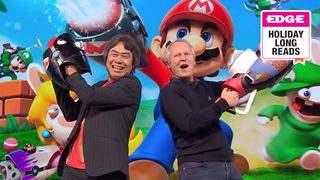
There is, even now, a note of disbelief in Davide Soliani’s voice. As he talks about the game that has consumed the last four years of his life, he can’t stop referring to it as “a dream”. Indeed, you sense the creative director of Mario + Rabbids: Kingdom Battle is still pinching himself, having spent so much quality time lately with a bona fide video game icon, a character who had been part of his life “even before he had a name”.
Yet it was in the N64 era where Soliani’s love affair with Mario began in earnest. “I remember arriving at the video game shop in Milan by motorcycle, dropping it on the floor without even caring about parking it, and then running inside and seeing Mario on screen in 3D for the very first time,” he says. “Holding this strange controller, moving the analogue stick and seeing him moving accordingly on screen, it was crazy. I could never have imagined that one day I’d be able to work on a Mario title.”
That opportunity was handed to him by Xavier Manzanares, who in 2013 was brand producer for Ubisoft’s Rabbids series. “My goal was to think about the games ahead for the Rabbids. In the past, we’d had very good discussions about the party games we did with Nintendo, talking about ideas and things that could work or not, but we’d never really put something on the table.”
At the end of the year, he decided it was time to propose something new and different: a reboot of sorts for the Rabbids series. “We wanted to take a risk and make something that no one expected. So I contacted three creative directors working within Ubisoft at that time.” Soliani, of course, was one of the three.

Manzanares’s outline was fairly loose: it had to be a game that combined the Rabbids and Mario in some way, but beyond that, there were no rules. It was now February 2014, and Soliani and four colleagues cloistered themselves in a small room at Ubisoft’s Milan studio, brainstorming ideas across a range of genres.
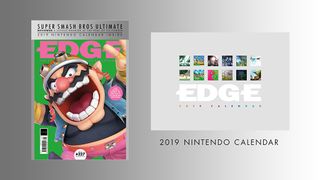
Subscribe to Edge Magazine in print or digital for more in-depth features, reviews and interviews about the future of interactive entertainment.
“We eventually came up with a list of 13 different games, spanning from racing games to firstperson shooters, because for us it was an exercise to see how many ideas we could come up with around the concept of Rabbids and Mario together,” Soliani explains. “One common point was to basically use the contrast between those two IPs to create a parody. We were basically trying to surprise ourselves.”
Manzanares was certainly surprised by the result. “I was just waiting for a proposal, and had given them only a few weeks to do it,” he recalls. But that wasn’t Soliani’s style. Instead, he sent Manzanares a huge mock poster, with fake screenshots and snippets of text. “We have it here – it’s almost like something you would put in a museum,” the producer smiles. “It was really weird as a proposal, but it was made with so much passion that I decided to stop working on the brand, refocus my attention on this game and start the adventure with Davide and his team.”
Sign up to the GamesRadar+ Newsletter
Weekly digests, tales from the communities you love, and more
If the idea of combining these two brands seemed unlikely, the notion that they’d join forces in a turn-based strategy game was even more fanciful. “OK, Rabbids and Mario might seem very far from each other,” Soliani adds. “Well, for us it was the key. To use those differences to propose something completely new.” But why a strategy game? “Because we wanted to propose something new in a genre, and do complex stuff in a very simple way,” Soliani says.
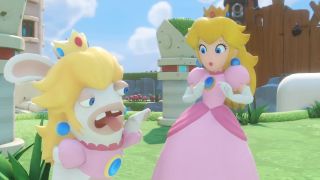
“Most tactical games are fun to play, but they look very sad in terms of their colour palette, and their complexity scares away players really easily.” Soliani and his team spent a lot of time discussing ways to make something that was deep yet accessible for all types of player. The defining moment came when the game’s movement abilities – the dash move that lets players slide-tackle enemy units, and the team- jump that lets friendly units use one another as springboards to bounce over gaps and cover greater distances – were conceived.
“Straight away, players could do complex stuff with a single click,” Soliani says. In fact, when the time came to present the first prototype to Nintendo, it didn’t look like a tactical game at all: the pitch showed the various techniques the player characters could perform, but with no HUD present, it wasn’t immediately clear how the game would play. “They saw it almost as a sequential action game,” Manzanares says.
Back then, Kingdom Battle was very different. The initial prototype was a real-time PvP-focused strategy game: the three-character setup was already established, but the player had a budget of time to move them all around the battlefield, controlling them directly rather than guiding them with a reticle as in the finished game. And each arena featured towers, which could be activated to expand the player’s radius of vision.Soliani and his team had taken great pains to prepare for that presentation. Keen to show they were taking their responsibilities seriously, they spent a lot of time carefully modelling, rigging and animating the Nintendo characters.
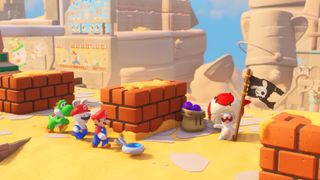
“Miyamoto-san was not expecting us to show a prototype directly, especially not a playable one,” Soliani grins. “He was probably expecting a discussion or a PowerPoint. But as a team we really wanted to show stuff instead of just talking.” And Nintendo was suitably impressed. “They especially were not expecting us to recreate their own characters in our game to the point that they said, more than once, ‘They look identical to ours!’” He laughs, proudly. “We told them we’d recreated them from scratch because we wanted to show that we respect those characters. I think that was the very moment we gained their trust.”
Good job, too, since this unlikely crossover was proposing that Mario would no longer jump on his opponents to defeat them, but rather shoot them with guns. They were, Soliani confirms, there from the very first prototype. “Compared to what we have in-game today, they were more simple – even more toy-like,” he says. And something working with Nintendo,” he begins. “Nothing is taken for granted. You never know how they will react. And the second thing I learned is that you have to be bold. Worst case scenario, they’ll tell you no. But they prefer you daring to propose stuff instead of being shy, that’s for sure.”
It took a little while for Manzanares and Soliani to reach the stage where they were more confident suggesting riskier ideas. The early stages of production were tricky, Manzanares says, because the scope of the game hadn’t yet been fully defined. The development team was, after all, working on a game for a console that hadn’t yet been revealed, and on an engine (Ubi’s own Snowdrop) with which it wasn’t yet fully familiar. But Nintendo’s passion for the project proved encouraging, its insistence on wanting to be surprised motivating a change in approach.
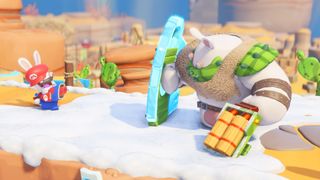
“We switched the focus of production, because they wanted to see Rabbid-ness to its full force,” Manzanares laughs. “We thought most of what we would suggest would be killed, in respect to what Mario is.” But as development progressed, discussions advanced to the stage where Nintendo would ask Ubisoft to push its weirder ideas even further. “Sometimes we got a ‘no’, but most of the time it was ‘yes’, and ‘please continue’.”
One example for which Soliani expected some pushback was the game’s first boss, Rabbid Kong. If a character gets too close, Kong will grab them and use their face to scratch his backside. “When we called Nintendo to describe it, we said, we would like to do it, but if you want we only do it with the Rabbids characters. But they were laughing like hell, and they said, ‘No no, please do it, even with our characters’,” Soliani says. Another came with the third boss, The Phantom, a Rabbid opera singer who repeatedly mocks Mario in song. That, too, was happily waved through, and Soliani realised a common trend: “If they were laughing, it was basically an okay.”
Rabbid Peach, apparently, was a particular favourite at Nintendo. Pushing the game’s comedic elements to the fore inevitably meant a lot of work for the animation team, not to mention the range of possible variables on the battlefield. Animation director Marco Renso and his team had studied YouTube videos and past Nintendo games to try to recreate the characterisation of the Mushroom Kingdom heroes for those early demonstrations, but those references could only carry them so far.
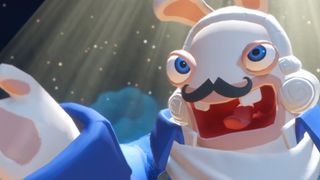
“A lot of the animations were very specific to our game and had to be validated by Nintendo afterwards, to be in line with how Mario would act, for example,” Manzanares explains. “We had to create brand new sets of animations that would fit gun handling, the cover system, and even some cinematics and interactions with other characters.”
“Miyamoto-san was not expecting us to show a prototype directly, especially not a playable one”
David Soliani, Creative Director
In terms of raw quantity, for the combat alone, each character required more than 1,000 individual animations, covering moves from cover, sprints, dashes, and the team-jump. “On top of that, we put in a lot of effort in terms of defining or building upon the psychology of the characters,” Soliani says. It was a huge effort, but the hard work of Renso and his team was rewarded with an unexpected endorsement. “The guys at Nintendo said they were going to show the cinematics to the Mario team because they were really, really nice, so that was a great honour.”
Kingdom Battle’s interface was perhaps more challenging still to refine: it evolved over “many, many playtests” and iterations, Soliani admits. At first, the combat used a fairly traditional strategy- game system for aiming accuracy, basing the percentage on a variety of factors ranging from distance to the type of cover, including modifiers for flanking, high and low ground and more. It was, he says, far too complex: the game had the depth it needed, but not the accessibility. Eventually, the team settled on a more easily understandable set of rules, whereby line of sight would remain a factor, but certain cover types would offer a straight 50/50 chance of getting hit or not. If a certain amount of Rabbid-ness was required, the team realised there was such a thing as too much chaos.
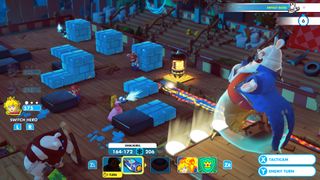
“We even had the concept of fumble at one time, where you could fumble your weapon and break it,” Manzanares explains. “We felt it was funny. But it was not funny to play.” Yet as the game entered its final stages, Soliani felt something was missing – and skill trees for each character were hurriedly added. “We needed to support a wider range of playstyles,” he says. “It was so huge that it affected everything within the combat system, because from that moment on players could spend points improving their movement or attacking abilities.” He laughs quietly, acknowledging his colleague. “A big thank you to Xavier for approving it.”
Then came the leaks, the game’s grand unveiling spoiled three weeks ahead of schedule. “Even when you know that this can potentially happen, seeing your game discussed and presented in a way that doesn’t represent everything you’ve being doing for so long is not something everybody can just deal with,” Manzanares says.
But with E3 around the corner, a speech already prepared, and work on a playable demo keeping everyone busy, there was a feeling of immense pride at the studio. “We couldn’t wait to go there, just to show to everyone that this was not just a crossover, a business deal, but something that came from our hearts,” he tells us. And, as the camera cut from a typically ebullient Miyamoto to an overwhelmed Soliani in the crowd at LA’s Orpheum Theatre, the world suddenly understood how true that was.
This article originally appeared in Edge Magazine. For more great gaming coverage, you can subscribe to Edge here.

Chris is Edge's deputy editor, having previously spent a decade as a freelance critic. With more than 15 years' experience in print and online journalism, he has contributed features, interviews, reviews and more to the likes of PC Gamer, GamesRadar and The Guardian. He is Total Film’s resident game critic, and has a keen interest in cinema. Three (relatively) recent favourites: Hyper Light Drifter, Tetris Effect, Return Of The Obra Dinn.
Most Popular

